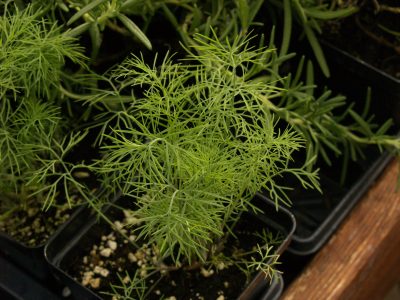Dill

Dill is an easy cool season herb to grow. Along with its tasty leaves and seeds for our recipes, it’s a pretty plant to mingle with flowers, vegetables and other herbs.
With its feathery bright green foliage and lovely upside-down-umbrella shaped inflorescence, dill makes a striking addition to any area of the garden.
Although many people plant dill in fall, it can succumb to winter freezes if temps drop below 25_. At our Travis County Extension demonstration beds, we plant it after the last freeze date.
You can plant from transplants or seeds. If planting from seed, just lightly scratch into the soil, since they are so small.
Dill is an annual that thrives in well-drained soil with lots of organic matter. It will bolt and flower when hot weather comes our way.
The flowers that signify bolting attract many beneficial insects to the garden. And, since it’s a larval plant for Swallowtail butterflies, don’t kill the caterpillars that enjoy it, too. Plant extras so you and wildlife can enjoy.
Dill grows very quickly and may tend to fall over, especially if exposed to windy conditions or if planted in too much shade. So be sure to give it at least 6 hours of sun and plant in a protected spot.
To harvest the seeds for cooking, cut the entire flower stalk just as the seeds begin to ripen, and then allow the stalk to dry. You can also use dill leaves in pickling, soups, and other savory dishes.
Harvest fresh leaves and use them immediately, since the flavor is lost fairly quickly. Cutting your dill to use in the kitchen will actually invigorate it, causing it to branch and grow and produce more leaves and flowers for harvest.
categories:







